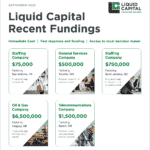Navigating unexpected supplier price increases
How can businesses remain competitive in today’s market when faced with navigating unexpected supplier price increases?

Small and medium-sized businesses have gone through tough times over the last few years. With unfavourable market conditions pushing businesses to make hard decisions, many companies are facing new and increasing challenges.
Decades-high inflation has made pricing and contracts more difficult to navigate, and, along with labour shortages and continuing supply-chain delays, some businesses have been struggling to keep moving forward.
This is particularly the case for B2B businesses that operate on small margins and offer fixed-price contracts, such as manufacturing or trucking and transportation companies.
Companies in manufacturing, transportation and energy have seen instances where suppliers have increased costs by as much as 20%, even though they had a contract in place at a lower price.
So how can business owners continue to deliver at the fixed-price contract rate? Keep reading as we examine this growing problem and how small and medium-sized business owners can overcome it.
Contract reneging is a wide-reaching issue
In recent months, we’ve heard of numerous instances where North American-based companies have had suppliers increase costs at short notice. This is causing strains to their cash flow and putting their client relationships at risk.
Manufacturing, transportation and energy have seen an increase in suppliers reneging on contract pricing. Often in these sectors, purchase agreements are locked in for years or are structured in such a way that they can’t simply pass along the increased costs to their customers.

If a business depends on one or two large accounts (such as a company that is selling products to a grocery chain or a transport company who provides exclusive shipping rights to a single customer) the last thing they want to do is damage or lose a contract.
So what is the driving force behind this phenomenon and what can business owners do to overcome the cash flow challenges it presents?
Dramatically shifting market conditions to blame
The fall-out from COVID-19 lockdowns and ongoing supply issues are partly to blame for the increase in supply prices. Continuing lockdowns in China (which is the world’s leading manufacturer, with almost 30% of the world’s output) have had serious impacts on the supply of goods and materials.
The Russian invasion of Ukraine has played a large part in the increase in global prices for oil, which in turn has raised the costs of transportation and the overall cost of a wide variety of supplies. The war has also caused an increase in energy and food costs, bringing a knock-on effect to the price of many other materials.
The cost of moving goods around the world has also increased considerably. In some places the price of transporting a container almost quadrupled within a year. Labour shortages and wage increases have also had an impact on the cost of most goods and materials.
These pressures have brought about unavoidable chain reactions: businesses’ costs have spiralled and so the goods they provide have also had to jump in price.
For the foreseeable future, these pressures are likely to remain for many businesses. Between 75% and 84% of businesses expect to continue seeing increased supply costs, supply shortages and delivery delays.
Manufacturers are facing almost $1 billion in increased costs, with 80% admitting that they have had to considerably raise their prices and delay deliveries of orders.
It looks likely, therefore, that suppliers reneging on contracts is likely to be a reality for many businesses, for some time to come.
How businesses are reacting to increased costs
To stay afloat, many small and medium-sized businesses know that they have to continue delivering on their contracts, regardless of higher costs they themselves may face. Increasingly, therefore, companies are reconsidering the viability of offering fixed-price contracts.
No business with small profit margins can continue to swallow price increases that can’t be passed on to the customer. More and more companies are providing estimates but no fixed price, so they have leeway to account for potential fluctuations in the cost of materials.
This is fine for the future, but how can companies manage increased costs which they can’t pass on to their customers, right now?
Financial ways to bridge the gap
Many companies will need extra financing to help bridge the gap between what they’re paying for materials and what they can charge their clients. They can, of course, apply for a loan or line of credit with their bank. However, the big banks are typically more risk-averse than other lenders, and less likely to approve loans to small businesses that are experiencing cash flow issues.
This is where alternative lenders could come into play. One option is asset-based lending, which provides businesses with a line of credit based on the company’s assets, and repayments which are made on a monthly basis.

There is also an option for businesses that need improved cash flow without taking on extra debt. Invoice factoring involves selling invoices for cash, meaning companies can get paid up-front, without having to wait 30, 60 or even 90 days. This can help businesses to deliver on their contract obligations without having to pay debt interest.
When traditional funding options aren’t available, many companies have benefited from alternative financing options to help them overcome the cash flow challenges posed by the current market conditions. The key is to find a partner who understands the company’s specific needs and is able to provide a funding solution that is in the best interest of the business’s long-term growth.













